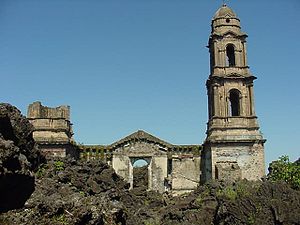- Parícutin
-
Parícutin 
Parícutin in 1994.Elevation 2,800 m (9,186 ft) [1] Prominence 424 m (1,391 ft) Location Location Uruapan Municipality, Michoacán, Mexico Coordinates 19°29′34.8″N 102°15′3.6″W / 19.493°N 102.251°WCoordinates: 19°29′34.8″N 102°15′3.6″W / 19.493°N 102.251°W Geology Type Cinder cone Age of rock 1941-present Volcanic arc/belt Trans-Mexican Volcanic Belt Last eruption 1952 Climbing First ascent 1943 Easiest route Hike Parícutin (or Volcán de Parícutin, also accented Paricutín) is a cinder cone volcano in the Mexican state of Michoacán, close to a lava-covered village of the same name. It appears on many versions of the Seven Natural Wonders of the World. Paricutín is part of the Michoacán-Guanajuato Volcanic Field, which covers much of west central Mexico.
Contents
History
The volcano began as a fissure in a cornfield owned by a P'urhépecha farmer, Dionisio Pulido, on February 20, 1943. Pulido, his wife, and their son all witnessed the initial eruption of ash and stones first-hand as they ploughed the field. The volcano grew quickly, reaching five stories tall in just a week, and it could be seen from afar in a month. Much of the volcano's growth occurred during its first year, while it was still in the explosive pyroclastic phase. The nearby villages Paricutín (after which the volcano was named) and San Juan Parangaricutiro were both buried in lava and ash; the residents relocated to vacant land nearby.
At the end of this phase, after roughly one year, the volcano had grown 336 meters (1,100 ft) tall. For the next eight years the volcano would continue erupting, although this was dominated by relatively quiet eruptions of lava that would scorch the surrounding 25 km² (9.7 mi²) of land. The volcano's activity would slowly decline during this period until the last six months of the eruption, during which violent and explosive activity was frequent. In 1952 the eruption ended and Parícutin went quiet, attaining a final height of 424 meters (1,391 ft) from the cornfield where it began. The volcano has been quiet since. Like most cinder cones, Parícutin is believed to be a monogenetic volcano, which means that once it has finished erupting, it will never erupt again. Any new eruptions in a monogenetic volcanic field erupt in a new location.
Volcanism is a common part of the Mexican landscape. Parícutin is merely the youngest of more than 1,400 volcanic vents that exist in the Trans-Mexican Volcanic Belt and North America. The volcano is unique in the fact that its formation was witnessed from its very inception. Three people died as a result of lightning strikes caused by the eruptions, but no deaths were attributed to the lava or asphyxiation.
Shots of the volcano during its active phase were included in 20th Century Fox's film Captain from Castile, released in 1947.
Gallery
Popular References
- A story version of the formation of this volcano can be found in the "I Can Read" book called Hill of Fire. It was presented by the children's television show "Reading Rainbow".
- Another story is found in Anita Ganeri's Violent Volcanoes, part of the Horrible Geography series
- It is mentioned in the 1997 film Volcano.
See also
Notes
- ^ Instituto Nacional de Estadística y Geografía (2005). "Elevaciones principales - Michoacán de Ocampo". http://mapserver.inegi.gob.mx/geografia/espanol/estados/mich/elecaciones.cfm?c=1208&e=16&CFID=83246&CFTOKEN=47858644. Retrieved 2010-04-25.
References
- Parícutin at Volcano World
- Parícutin: The Volcano Born in a Mexican Cornfield, Edited by James F Luhr and Tom Simkin, Phoenix AZ: Geoscience Press, 1993. The definitive collection of reports and documentary illustrations of the eruption and its effects up to the date of publication.
- Peakbagger.com Parícutin: Credits. Retrieved Apr. 16, 2008.
- Volcano World (El Jorullo). Parícutin: Credits. Retrieved Apr. 17, 2008.
External links
Categories:- Volcanoes of Mexico
- Mountains of Mexico
- Pyroclastic cones
- Destroyed cities
- Natural disasters in Mexico
- Cinder cones
- 1943 natural disasters
- Geology of Mexico
- Monogenetic volcanoes
- VEI-4 volcanoes
Wikimedia Foundation. 2010.




